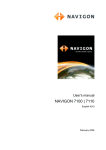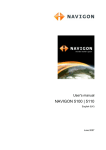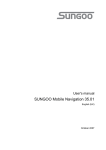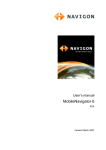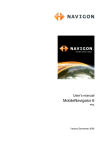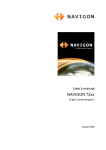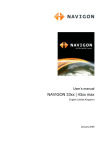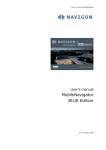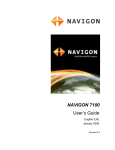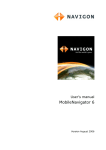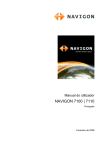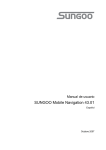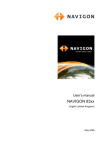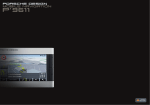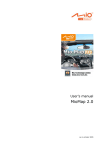Download NAVIGON 7100 | 7110 - produktinfo.conrad.com
Transcript
User's manual NAVIGON 7100 | 7110 English (UK) June 2007 This symbol showing a crossed-through refuse container signifies that, within the European Union, the product must be disposed of as sorted waste. This applies both to the product itself, as well as to all accessories that carry this symbol. This product may not be disposed of with unsorted household waste. Imprint NAVIGON AG Schottmüllerstraße 20A D-20251 Hamburg The information contained herein may be changed at any time without prior notification. This manual nor any parts thereof may not be reproduced for any purpose whatsoever without the express written consent of NAVIGON AG, nor transmitted in any form either electronically or mechanically, including photocopying and recording. All technical specifications, drawings etc are subject to copyright law. © 2007, NAVIGON AG All rights reserved. User's manual NAVIGON 7100 | 7110 Table of Contents 1 Introduction .......................................................................................7 1.1 1.2 1.3 2 3 4 About this manual.....................................................................................7 1.1.1 Conventions ...............................................................................7 1.1.2 Symbols......................................................................................7 Legal notice ..............................................................................................7 1.2.1 Liability .......................................................................................7 1.2.2 Trademarks ................................................................................7 Customer Service.....................................................................................8 Before you begin.............................................................................10 2.1 Scope of Delivery ...................................................................................10 2.2 Description of the NAVIGON 7100 | 7110..............................................11 2.3 Preparing NAVIGON 7100 | 7110 for use ..............................................12 2.3.1 Assembling the mains adapter .................................................12 2.3.2 Charging the rechargeable battery...........................................12 2.3.3 Inserting a memory card...........................................................12 2.3.4 Preparing the navigation system for use ..................................13 2.4 Navigation with GPS ..............................................................................14 2.5 Important safety information...................................................................14 2.5.1 Navigation safety information ...................................................14 2.5.2 Safety information for the navigation device ............................15 2.5.3 Safety guidelines when installing in your car............................16 Operating the navigation software ................................................16 3.1 Volume .................................................................................................16 3.2 Information .............................................................................................17 3.3 Software keyboard .................................................................................18 3.4 Lists 3.5 Options .................................................................................................19 3.6 Menus .................................................................................................19 .................................................................................................20 Password Lock................................................................................20 4.1 Activating password protection...............................................................20 4.2 Changing a password.............................................................................20 4.3 Cancelling password protection .............................................................21 User's manual Table of Contents III User's manual NAVIGON 7100 | 7110 4.4 Switching on NAVIGON 7100 | 7110 .....................................................21 4.4.1 5 5.1 Starting NAVIGON 7100 | 7110 .............................................................22 5.1.1 5.2 5.3 6 7 Initialising the GPS-receiver .....................................................22 Specifying a new destination..................................................................23 5.2.1 Specifying the destination country............................................23 5.2.2 Destination address..................................................................24 5.2.3 Special destinations .................................................................25 5.2.4 Quick access to special destinations........................................27 5.2.5 Information about the destination .............................................27 Selecting a saved destination.................................................................28 5.3.1 Last Destinations......................................................................28 5.3.2 Favourites.................................................................................28 5.4 Navigating homewards...........................................................................29 5.5 Voice commands....................................................................................29 5.6 Determining destinations on the map.....................................................30 5.7 Starting navigation..................................................................................30 Managing Destinations...................................................................32 6.1 Saving a destination ...............................................................................32 6.2 Defining a destination as home address ................................................32 6.3 Setting up a voice command ..................................................................32 Routes with stages .........................................................................33 7.1 7.2 7.3 8 Forgotten your password?........................................................21 Navigation .......................................................................................21 Route planning .......................................................................................33 7.1.1 Entering the starting point ........................................................33 7.1.2 Entering route points ................................................................34 7.1.3 Editing route points...................................................................34 Managing routes.....................................................................................35 7.2.1 Saving routes ...........................................................................35 7.2.2 Loading routes..........................................................................35 Navigation ..............................................................................................35 7.3.1 Calculating and displaying routes.............................................35 7.3.2 Simulating routes......................................................................36 7.3.3 Starting navigation....................................................................36 Options ............................................................................................37 IV Table of Contents User's manual User's manual NAVIGON 7100 | 7110 9 Working with the map.....................................................................39 9.1 Maps 9.2 Map in Preview mode.............................................................................40 9.3 Map in Navigation mode.........................................................................41 9.4 Reality View............................................................................................43 9.5 Map in Destination search mode............................................................44 9.5.1 10 .................................................................................................39 Operating in Destination search mode .....................................45 Useful functions..............................................................................46 10.1 GPS status, storing the current location.................................................46 10.2 Turn-by-Turn List....................................................................................47 10.2.1 Blocking route sections ............................................................47 10.2.2 Removing blocks and using original routes..............................48 10.3 TMC (Traffic Information) .......................................................................48 10.3.1 Displaying traffic messages......................................................48 10.3.2 TMC Settings............................................................................48 10.4 Logbook .................................................................................................49 11 12 Configuring NAVIGON 7100 | 7110 ................................................50 Handsfree Module...........................................................................51 12.1 Opening the hands-free module.............................................................51 12.2 Closing the hands-free module ..............................................................52 12.3 Connecting to a telephone .....................................................................52 12.3.1 Pairing with a mobile phone .....................................................52 12.3.2 Connecting to a mobile phone..................................................52 12.4 Accepting a call ......................................................................................53 12.5 Calling .................................................................................................53 12.5.1 Dialling a telephone number.....................................................53 12.5.2 Calling most recently dialled, received or missed numbers .....54 12.5.3 Dialling on the mobile phone ....................................................54 12.6 During a call ...........................................................................................54 12.6.1 Adjusting the volume ................................................................55 12.6.2 Muting the microphone.............................................................55 12.6.3 Transferring a call to the mobile phone ....................................55 12.6.4 Transferring a call from your mobile telephone ........................55 12.6.5 Entering numbers .....................................................................56 12.6.6 Bringing the navigation software to the foreground..................56 User's manual Table of Contents V User's manual NAVIGON 7100 | 7110 12.6.7 Ending the call..........................................................................57 12.7 Hands-free module troubleshooting .......................................................57 13 Appendix .........................................................................................58 13.1 Technical data ........................................................................................58 13.2 Declaration of Conformity.......................................................................59 14 Index ................................................................................................60 VI Table of Contents User's manual User's manual NAVIGON 7100 | 7110 1 Introduction 1.1 About this manual 1.1.1 Conventions For better legibility and clarification, the following styles are used in this manual: Bold and italics: Registered names, company and product descriptions. SMALL CAPITALS: Window and dialogue box titles. Bold: Highlighting of important parts in the text. Underlined: Descriptions of buttons, input fields and other elements on the user interface. 1.1.2 Symbols The following symbols refer to specific passages of text: Instructions and tips for operating the software More detailed information and explanations Warnings 1.2 Legal notice 1.2.1 Liability The software and the manual are subject to change without notice. NAVIGON AG is not liable for the accuracy of the information contained in this manual or for damages resulting from the use of this manual. We always appreciate any suggestions that will allow us to offer improved performance of our products in the future, or information regarding malfunction. 1.2.2 Trademarks All brands and trademarks mentioned in this document are possibly registered by third parties and are subject to the current legislation and Introduction -7- User's manual NAVIGON 7100 | 7110 to the rights of their respective owners without reservation. All mentioned names of products, societies, or brands may be registered trademarks of their respective owners. Every right that is not explicitly accorded is reserved. The absence of the explicit labelling of registered trademarks used in this manual does not imply that the brand is not subject to the rights of a third party. ► ► 1.3 Windows and ActiveSync are trademarks of the Microsoft Corporation. NAVIGON is a registered trademark of NAVIGON AG. Customer Service Our service team staff are available via telephone or E-mail in many countries. You can find additional information at the NAVIGON AG website under (www.navigon.com) in the "Service & Support" section. Telephone Support Note: All quoted costs refer to calls made from a land line within the relevant country. Germany Telephone: Service times: Costs: 01805-6284466 Monday to Saturday from 8 a.m. to 8 p.m. CET € 0.14/min. Belgium Telephone: Service times: Costs: 0900-70016 Monday to Friday from 8 a.m. to 8 p.m. CET € 0.45/min. + € 0.05 per call Denmark Telephone: Service times: Costs: 901-31033 Monday to Friday from 8 a.m. to 8 p.m. CET 3.00 DKK/min. Finland Telephone: Service times: Costs: -8- 0600-413414 Monday to Friday from 9 a.m. to 9 p.m. hrs (local time) € 0.50/min. Introduction User's manual NAVIGON 7100 | 7110 France Telephone: Service times: Costs: 0891-650065 Monday to Saturday from 8 a.m. to 8 p.m. CET € 0.225/min. Great Britain Telephone: Service times: Costs: 0905-8480701 Monday to Friday from 7 a.m. to 7 p.m. (local time) 0.25 GBP/min. Telephone: Service times: Costs: 166-205301 Monday to Friday from 8 a.m. to 8 p.m. CET € 0.40/min. + € 0.09 per call Italy Netherlands Telephone: Service times: Costs: 0900-0400468 Monday to Friday from 8 a.m. to 8 p.m. CET € 0.30/min. + € 0.045 per call Norway Telephone: Service times: Costs: 820-33050 Monday to Friday from 8 a.m. to 8 p.m. CET 3.26 NOK/min. Telephone: Service times: Costs: 0820-240437 Monday to Friday from 8 a.m. to 8 p.m. CET € 0.145/min. Austria Sweden Telephone: Service times: Costs: 0900-1001110 Monday to Friday from 8 a.m. to 8 p.m. CET 4.00 SEK/min. Switzerland Telephone: Service times: Costs: Introduction 0848-662544 Monday to Friday from 8 a.m. to 8 p.m. CET 8 a.m. - 5 p.m.: 0.11 CHF/min 5 p.m. - 10 p.m.: 0.09 CHF/min 10 p.m. - 8 a.m.: 0.06 CHF/min. -9- User's manual NAVIGON 7100 | 7110 Spain Telephone: Service times: Costs: 807-001205 Monday to Friday from 8 a.m. to 8 p.m. CET 8 a.m. - 8 p.m.: € 0.356/min. + € 0.104 per call 8 p.m. - 8 a.m.: € 0.288/min. + € 0.104 per call Other countries Telephone: Service times: Costs: +49-221-2888-999 Monday to Friday from 8 a.m. to 8 p.m. CET dependent on telephone provider Support via E-mail Danish: German: English: Finnish: French: Italian: Dutch: Norwegian: Swedish: Spanish: [email protected] [email protected] [email protected] [email protected] [email protected] [email protected] [email protected] [email protected] [email protected] [email protected] 2 Before you begin 2.1 Scope of Delivery Please check that the contents of the delivery are complete. If the contents are incomplete, please notify us within 14 days of purchasing. The purchased product includes the following: - 10 - ► NAVIGON 7100 | 7110 navigation device ► Car cradle ► Car charger cable ( 12V-adapter for the vehicles cigarette lighter) ► Mains adapter ► USB-cable ► SD-card containing software and navigation maps ► Manual ► CD with manuals (PDF, including languages not printed) ► Pouch Before you begin User's manual NAVIGON 7100 | 7110 2.2 Description of the NAVIGON 7100 | 7110 1 Touch screen 2 Microphone 3 Reset 4 Headset socket (also used to connect TMC-antenna) 5 LED 6 Mini-USB-socket for USB-cable / Mains adapter / Car charger cable 7 Stylus 8 Show Map 9 On/Off/Standby 10 Slot for SD-memory card 11 Connection for external GPS-antenna Before you begin - 11 - User's manual NAVIGON 7100 | 7110 2.3 Preparing NAVIGON 7100 | 7110 for use 2.3.1 Assembling the mains adapter The mains adapter has an operating voltage of 100~240V, several different mains socket adapters are provided. This ensures trouble-free charging of the navigation device when abroad. ► 2.3.2 Push the appropriate mains socket adapter (dependent on location) into the designated slot on the mains adapter until it locks into place. Charging the rechargeable battery It is possible that the rechargeable battery is not fully charged when you remove it from the packaging. We recommend that you fully charge the battery before using the device for the first time. ► Connect the mains adapter to the navigation device and to a mains socket. The LED of the NAVIGON 7100 | 7110 lights orange during charging. The LED lights green when the NAVIGON 7100 | 7110 is fully charged. Note: It takes approx. 4-5 hours to charge the device when the battery is flat. A fully charged battery enables 4 hours of use. 2.3.3 Inserting a memory card ► Insert the memory card provided into the device (see image). Press the card into the device until it locks into place. Removing the memory card 1. Switch the navigation device off by pressing the (On/Off/Standby) switch for at least 6 seconds. - 12 - Before you begin User's manual NAVIGON 7100 | 7110 2. Press the memory card gently into the device until the lock disengages. 2.3.4 Preparing the navigation system for use Caution! Please be sure to refer to the safety information in chapter "Important safety information" on page 14. Securing the cradle 1. Clean that part of the windscreen to which you would like to secure the cradle. The windscreen must be dry and free of dirt and grease. 2. Using the suction cup, fix the cradle provided to the windscreen. The cradle should be as level as possible. 3. Press the lever on the suction cup down. Securing the navigation device to the cradle The navigation device is secured to the cradle by means of a bayonet fitting. This connection functions in a similar way to attaching a lens to a camera or putting the lid on a pressure cooker. 1. Place the navigation device on the bayonet in such a way that the bulges on the bayonet ring correspond exactly with the recesses on the cradle. This is achieved by rotating it approx. 30° to the left. 2. Turn the navigation device clockwise until the bayonet fitting locks into place. 3. Adjust the navigation device so that it can be seen easily. Supplying power to the navigation device Included in delivery of the NAVIGON 7100 | 7110 is a car charger cable with which power can be supplied to the navigation device via the vehicle's cigarette lighter. The car charger cable is connected to the NAVIGON 7100 | 7110 via the mini-USB-socket on the bottom of the device. Caution! The car charger cable is to be connected to cigarette lighters with an operating voltage of 12V only. Connecting the TMC-antenna The NAVIGON 7100 | 7110 has an integrated TMC-receiver. For optimal reception, you should use the TMC-antenna provided. 1. Connect the TMC-antenna to the headset socket bottom of the NAVIGON 7100 | 7110. Before you begin on the - 13 - User's manual NAVIGON 7100 | 7110 2. Secure the antenna to the windscreen using the suction cups. 2.4 Navigation with GPS GPS is based on a total of 24 satellites that circle the earth and, in doing so, are constantly transmitting their position and time. The GPS receiver receives this data and calculates its own geographical position on the basis of the information transmitted by the various satellites. For a sufficiently precise positioning it is necessary to obtain the data from at least three satellites. With the data from 4 or more satellites the altitude above sea level can also be ascertained. The determination has an accuracy of about 3 yards. Once the navigation device has determined your position, this position can be used as a starting point for route calculation. The map data on your navigation device includes the geographical coordinates of all digitally recorded points of interest, streets and places. This enables the device to calculate a route between a starting point and a destination. The calculation of the current position and its representation on the map takes place once every second. So your current position is always shown on the map. 2.5 Important safety information In your own interest, please read the following notices and safety information carefully before starting up your navigation system. 2.5.1 Navigation safety information Use navigation system at your own risk. Caution! To prevent accidents, do not operate the navigation system while driving. Caution! Do not look at the display unless it is absolutely safe to do so! Caution! Traffic regulations have priority over any instructions from the navigation system. Caution! Only follow the instructions of the navigation system when the circumstances and the road traffic regulations allow you to do so! The navigation system will guide you to your destination even if you deviate from the calculated route. - 14 - Before you begin User's manual NAVIGON 7100 | 7110 Caution! Check that the cradle is secured and adjusted properly before each journey. Note: If you have not understood the spoken instructions, or you're not sure about what to do next, you can refer briefly to the map or arrow view of your navigation system. 2.5.2 Safety information for the navigation device Caution! Protect the device from moisture. The device is neither waterproof nor is it protected against splash water. Caution! Do not run cables directly next to safety-relevant devices and supply lines. Caution! After installation, check all safety-relevant equipment in the car. Caution! Unplug the navigation device's power supply when you park the vehicle. The navigation device requires power in standby-modus, and may drain the vehicle's battery. Caution! Do not open the navigation device's casing under any circumstances. Caution! Do not expose the navigation device to extreme heat or cold. This may damage the device or impair its function. Caution! Use only the charger provided or one that has been approved of by the manufacturer. Connect the charger to a suitable power supply. The voltage requirements can be found on the device case and/or the packaging. Note: Ensure that there are no kinks in the cable and that it will not be damaged by any sharp objects. Note: To clean the navigation device, use a moist cloth only . Note: Do not unplug by pulling on the cable. Doing so could damage the cable! Before you begin - 15 - User's manual NAVIGON 7100 | 7110 Note: Create a backup of the data contained on the memory card provided. Note: The memory card must remain inserted in the device during operation of the navigation system. Note: Use SD- or MMC-memory cards only! Ensure that memory card contacts are clean and undamaged. 2.5.3 Safety guidelines when installing in your car Caution! Secure the cradle and the TMC-antenna in such a way that the driver's visibility is not impaired. Caution! Do not attach the cradle within the deployment zone of airbags. Caution! When installing the cradle, ensure that it does not represent a risk in the event of an accident. Caution! Do not run cables directly next to safety-relevant devices and power supplies. Caution! After installation, check all safety-relevant equipment in the car. Caution! The car charger cable is to be connected to cigarette lighters with an operating voltage of 12V only. 3 Operating the navigation software 3.1 Volume The volume of the spoken driving instructions can be adjusted during navigation. You have started navigation. The map is open in Navigation or Destination search mode. 1. Tap the (Volume) button. The volume bar opens. It contains three buttons for adjusting the volume: - 16 - Operating the navigation software User's manual NAVIGON 7100 | 7110 (Louder), 2. Tap the (Quieter), (Volume on/off). (Volume) button again. The volume bar closes. 3.2 Information Symbols located at the top of the screen are used to display information. GPS The GPS symbol can show the following GPS-reception status: No GPS: The built-in GPS receiver is not operational. Contact customer service if the problem persists. No Signal: Data is being received from less than three satellites. Position cannot be calculated. GPS Ready: Data is being received from at least three satellites. Position can be calculated. For more detailed information regarding GPS status, please refer to chapter "GPS status" on page 46. Energy The Energy symbol can display the following conditions of the built-in battery: The device is being supplied by an external power source. The battery is being charged. The device is being supplied by its internal battery. The battery charge is sufficient. The device is being supplied by its internal battery. The battery charge is low. Direction The Direction symbol shows you in which direction you are currently heading. It can show the following points of the compass: N, NE, E, SE, S, SW, W and NW. Operating the navigation software - 17 - User's manual NAVIGON 7100 | 7110 TMC (Traffic Information) The NAVIGON 7100 | 7110 has an integrated TMC-receiver which provides the navigation system with up to date traffic messaging. If necessary, it can alter the route dynamically in order to avoid a traffic jam for example. Note: This function is only available if TMC traffic messages are being transmitted in the country in which you are travelling. This is not the case in all countries. The TMC symbol can display the following TMC-reception status: No Symbol: There is no TMC receiver connected, or the connected or built-in TMC receiver is not operational. Tuning: The TMC-receiver is operational, but cannot find a station that is transmitting TMC signals. TMC on Standby: Traffic messages can be received. For details on TMC functionality, please refer to chapter "TMC (Traffic Information)" on page 48. Bluetooth The NAVIGON 7100 | 7110 has an integrated Bluetooth hands-free module. This enables you to use the device as a hands-free kit for a mobile phone with Bluetooth capability. The Bluetooth symbol can display the following states for the handsfree module: No Bluetooth: Bluetooth is deactivated. Connected: The NAVIGON 7100 | 7110 is connected to another device. Not connected: The NAVIGON 7100 | 7110 is not connected to another device. Bluetooth is activated. 3.3 Software keyboard A software keyboard appears on the screen when text entries are necessary. - 18 - Operating the navigation software User's manual NAVIGON 7100 | 7110 All entries can be made on the software keyboard using the fingertips. Only capital letters can be entered. When entering town or street names you need not enter any special characters or umlauts. The navigation system fills in these characters for you automatically. If, for example, you are searching for “Würzburg”, then simply enter "WURZBURG". Special characters may be helpful when naming saved destinations and itineraries, however. Special keys enters a space character. deletes the character in front of the cursor. opens the numeric keypad. opens the letter keyboard. opens the special character keyboard. As soon as you have entered a special character, the letter keyboard reappears automatically. 3.4 Lists Often, lists appear from which you can select an entry. This is the case, for example, when you enter a location. As soon as you enter the first letter, the largest city in the country specified which begins with this letter appears. As soon as you enter the second letter, a list appears with all locations that begin with the letters entered. If you enter additional letters, the list adapts to your entries. It only contains entries that begin with the text that has been entered or contain the text in the name. The more letters you enter, the shorter the list will become. You can toggle the list by means of the buttons. (Up) and (Down) In order to accept an entry from the list, simply tap on it. The list closes as soon as you have accepted an entry. 3.5 Options Some windows offer options that lead to further functions. Operating the navigation software - 19 - User's manual NAVIGON 7100 | 7110 A description of all available options can be found in chapter "Options" on page 37. 3.6 Menus Some buttons have menus which open when activated. Tap on a menu button to execute its function. If you would like to quit the options list without selecting a function, tap on the button you used to open the menu. 4 Password Lock By creating a password, you can protect your navigation system from unauthoriised use. Note: Password protection only comes into effect after the navigation device has been switched off completely. To do this, press the (On/Off/Standby) switch for at least 6 seconds. 4.1 Activating password protection 1. In the MAIN WINDOW, tap on Options > Settings > Options > Password Lock. The PASSWORD LOCK window opens. 2. Enter a new password in the New password field. 3. Enter this password in the Confirm new password field again. 4. Tap the Save password button. Note: The password must contain precisely 4 digits. 4.2 Changing a password 1. In the MAIN WINDOW, tap on Options > Settings > Options > Password Lock. The PASSWORD LOCK window opens. 2. Enter the password that is currently valid in the Old password field. 3. Enter a new password in the New password field. 4. Enter the new password in the Confirm new password field again. 5. Tap the Password Lock button. - 20 - Password Lock User's manual NAVIGON 7100 | 7110 Note: The new password must contain precisely 4 digits. 4.3 Cancelling password protection The PASSWORD LOCK window is open. 1. Tap on Options > Deactivate password lock 2. Enter the password that is currently valid in the Enter password field. 3. Tap the Deactivate password lock button. 4.4 Switching on NAVIGON 7100 | 7110 1. Press the (On/Off/Standby) switch for at least 6 seconds. If password protection has been activated, the ENTER PASSWORD window opens. 2. Enter the password. 3. Tap the Continue button. 4.4.1 Forgotten your password? If you have forgotten your password, proceed as follows: 1. Tap the (Info) button. 2. Call the number displayed in the window. 3. Follow the instructions given by the service personnel. Note: This service incurs costs. Information on tarifs can be obtained from your telecom provider. 5 Navigation Use navigation system at your own risk. Caution! Please be sure to refer to the safety information in chapter "Important safety information" on page 14. Impaired GPS reception If GPS reception is impaired, navigation will be interrupted. The navigation software remains active. Navigation - 21 - User's manual NAVIGON 7100 | 7110 As soon as GPS reception is restored, the navigation system calculates any change of position which has occurred in the meantime. Navigation may simply be continued. Arriving at your destination When you have reached the specified destination, a message to this effect will be displayed. Only your current position (triangle in orange) will now be shown on the map. 5.1 Starting NAVIGON 7100 | 7110 1. Switch your navigation device on. Each time the navigation device has been switched off completely (On/Off/Standby) switch for at least 6 seconds) (by pressing the the following message appears when the software is started again: "Please note that the road traffic regulations are prior to the instructions of the navigation system. Please do not operate the device while driving." 2. After you have read and fully understood the text, tap the OK button. 3. If you do not accept these instructions, then tap the Cancel button in order to quit the navigation software. The MAIN WINDOW will open. You can reach all of the navigation software functions via the MAIN WINDOW. 5.1.1 Initialising the GPS-receiver Note: It can take up to 20 minutes to initialise the integrated GPS receiver for the first time. Each time you switch on the receiver after this, the GPS reception will start within one minute. If the navigation device has been switched off for more than a week, the next initialisation can take up to 10 minutes. As soon as the navigation device has been switched on, initialisation of the GPS-receiver will begin. In the right-hand top corner of the display, you will see the GPS symbol. As soon as data from at least 3 satellites is received, the symbol changes to - 22 - GPS Ready. Navigation User's manual NAVIGON 7100 | 7110 Note: If the GPS symbol displays GPS Ready after considerably less than 20 minutes, it is advisable to leave the receiver switched on for at least a further 15 minutes so as to ensure reliable operation. Caution! If you have connected the navigation device to the power supply via the vehicle's cigarette lighter, remove the connector before you leave the vehicle standing for a longer period of time. As the GPS receiver requires a constant supply of power, it could drain the vehicle´s battery. Opening the Main Window The MAIN WINDOW opens when the navigation software starts. If another window is open, tap the previous window will open. Tap the opens. 5.2 (Back) button. The (Back) button repeatedly, until the MAIN WINDOW Specifying a new destination New destinations for the NAVIGON 7100 | 7110 are all destinations that you have not yet navigated, or you have not yet stored. You can enter an address here, select a special destination, or select a destination from the quick search function. When you enter a new destination for the first time, the COVERED list opens. COUNTRIES Tap on the country in which your destination lies. 5.2.1 Specifying the destination country Above the right-hand upper corner of the uppermost entry field of the ADDRESS, POI IN A CITY, and POI OF NATIONAL SIGNIFICANCE windows, is the Country button. It shows the country code of the country from which navigation destinations can currently be entered. If your destination is in a different country, then proceed as follows: 1. Tap the Country button. The COVERED COUNTRIES list opens. 2. Tap on the country in which your destination lies. The COVERED COUNTRIES list closes again. The symbol will display the country code of the destination country. Navigation - 23 - User's manual NAVIGON 7100 | 7110 Note: Only countries of which at least a part is represented on the currently loaded map may be selected. 5.2.2 Destination address 1. In the MAIN WINDOW, tap on New Destination > Enter an Address. The INPUT SEQUENCE menu opens when you enter addresses for the USA or Canada (and the corresponding map has been selected). 1a Select whether you would like to enter the street first and then the location (Street First), or first the location and then the street (City First). Note: For the following instructions, it is assumed that you have selected City First as the order for entering addresses. The ADDRESS window opens. 2. Enter the name or the postal code of the destination location. 3. Enter the name of the destination street. You can also enter the name of a well-known object, e.g. "Olympic stadium" or "Eiffel tower". 4. Enter the house number. If you don't know the number of the house, or you specified an object in the preceding step, then leave the field empty. If you don't know the house number, but know the name of a nearby side street, then tap on the Cross Street field and enter the name of this street. The navigation system will calculate a route to the intersection of the streets you have specified. Note: It is not necessary to enter all the address details. If you specify the town only, the navigation system will calculate a route to the town centre. If you specify the town and street without specifying a house number or side street, the navigation system will calculate a route to the centre of the street specified. 5. Tap the Start Navigation button. The map opens in Preview mode. Note: For detailed information on how to start navigation, please refer to chapter "Starting navigation" on page 30. - 24 - Navigation User's manual NAVIGON 7100 | 7110 5.2.3 Special destinations Special destinations, also called POIs (Points Of Interest) for short, are useful addresses that are catalogued according to particular criteria. Special destinations include ports, airports, restaurants, hotels, petrol stations, public buildings, doctor's surgeries, hospitals, shopping centres, etc. Special destinations can be displayed on the map by means of a symbol. In the MAIN WINDOW, tap on Options > Settings > POI to select the categories to be displayed on the map. Special destinations nearby Special destinations nearby, are special destinations that are located within a given radius of your current location. This means you can always find the nearest petrol station for example, no matter where you are. Note: GPS-reception must be sufficient for determining position. You can see if GPS-reception is sufficient by looking at the (GPS Ready) symbol. For more detailed information, please refer to chapter "GPS status" on page 46. Note: In quick access mode, there are three categories of special destinations available from the current vicinity, which can be searched for quickly and without additional entry. For more detailed information, please refer to chapter "Quick access to special destinations" on page 27. 1. In the MAIN WINDOW, tap on New Destination > Search for POI > Nearby. The POI NEARBY window opens. 2. Specify a category from which you would like to select a special destination. If sub-categories exist for the category you have selected, the Sub Category list will open. 3. Specify a sub-category from which you would like to select a special destination. The Name of the Destination list opens. It contains the nearest special destinations in the specified category, sorted by distance. 4. Tap on the name of the destination. 5. Tap the Start Navigation button. The map opens in Preview mode. Navigation - 25 - User's manual NAVIGON 7100 | 7110 For detailed information on how to start navigation, please refer to chapter "Starting navigation" on page 30. Special destinations of nationwide significance Special destinations of nationwide significance are airports, places of interest, national monuments, large ports etc. This enables you to find places of interest, for example, without having to know the name of the location. 1. In the MAIN WINDOW, tap on New Destination > Search for POI > Nationwide. The POI OF NATIONAL SIGNIFICANCE window opens. 2. Specify a category from which you would like to select a special destination. The Name of the Destination list opens. It contains the nearest special destinations in the specified category, sorted by distance. 3. Tap on the name of the destination. 4. Tap the Start Navigation button. The map opens in Preview mode. For detailed information on how to start navigation, please refer to chapter "Starting navigation" on page 30. Special destinations in a given location Special destinations in a given location can be useful when navigating in an unfamiliar town. 1. In the MAIN Window, tap on New Destination > Search for POI > in a City. The POI IN A CITY window opens. 2. Enter the name or the postal code of the destination location. 3. Specify a category from which you would like to select a special destination. If sub-categories exist for the category you have selected, the Sub Category list will open. 4. Specify a sub-category from which you would like to select a special destination. The Name of the Destination list opens. It contains special destinations from the specified category, sorted alphabetically. 5. Tap on the name of the destination. - 26 - Navigation User's manual NAVIGON 7100 | 7110 6. Tap the Start Navigation button. The map opens in Preview mode. For detailed information on how to start navigation, please refer to chapter "Starting navigation" on page 30. 5.2.4 Quick access to special destinations The quick access system contains three categories of special destinations. Destinations in your vicinity that correspond to these categories can be listed quickly, without the need for additional entry. ► In the MAIN Window, tap on Options > Settings > POI to select the categories available in the quick access system. Note: GPS-reception must be sufficient for determining position. You can see if GPS-reception is sufficient by looking at the (GPS Ready) symbol. For more detailed information, please refer to chapter "GPS status" on page 46. 1. In the MAIN WINDOW, tap the New Destination button. The NEW DESTINATION menu opens. The symbols of the categories which have been selected for quick access can be seen in the menu at the bottom. 2. Tap on a category from which you would like to select a special destination. The Name of the Destination list opens. It contains the nearest special destinations in the specified category, sorted by distance. 3. Tap on the name of the destination. The map opens in Preview mode. For information on how to start navigation, please refer to chapter "Starting navigation" on page 30. 5.2.5 Information about the destination For many destinations that you specify, there will be further information available, stored in the navigation system's database. For example, for many restaurants there is a telephone number available. You can then call the restaurant in order to reserve a table, for example. One of the destination entry windows described is open. ► Navigation Tap the (Destination Info) button. - 27 - User's manual NAVIGON 7100 | 7110 The DESTINATION INFO window opens. It contains all the information about the specified destination that is stored in the navigation system's database. ► ► ► Tap the Cancel button to close the DESTINATION INFO window. Tap the map. (Show on Map) button to show the destination on the Tap the (Call) button to call the number entered. Note: The Call function is only available when the NAVIGON 7100 | 7110 is connected via Bluetooth to a mobile phone. For detailed information about connecting to a mobile phone, please refer to chapter "Handsfree Module" on page 51. 5.3 Selecting a saved destination The following lists of destinations and addresses are available for selection in NAVIGON 7100 | 7110 under My Destinations. ► ► 5.3.1 LAST DESTINATIONS: destinations that you have previously navigated to. FAVOURITES: all destinations that you have stored in NAVIGON 7100 | 7110. Last Destinations NAVIGON 7100 | 7110 saves the last 30 destinations to which you have navigated in the LAST DESTINATIONS list. 1. In the MAIN WINDOW, tap on My Destinations > Last Destinations. 2. Tap the destination to which you would like to navigate. 3. Tap the Start Navigation button. The map opens in Preview mode. For detailed information on how to start navigation, please refer to chapter "Starting navigation" on page 30. 5.3.2 Favourites Destinations to which you often travel can be saved in the FAVOURITES list. In the FAVOURITES list, up to 300 destinations can be saved. - 28 - Navigation User's manual NAVIGON 7100 | 7110 Information on how to store a destination can be found in chapter "Saving a destination" on page 32. 1. In the MAIN WINDOW, tap on My Destinations > Favourites. 2. Tap the destination to which you would like to navigate. 3. Tap the Start Navigation button. The map opens in Preview mode. For detailed information on how to start navigation, please refer to chapter "Starting navigation" on page 30. 5.4 Navigating homewards In NAVIGON 7100 | 7110 you can save your address as home address. You can navigate to your home address at anytime by activating a single button. The first time you tap the Take Me Home button, you will be requested to enter your address. Further information about entering your home address can be found in chapter "Defining a destination as home address" on page 32. ► In the MAIN WINDOW, tap the Take Me Home button. If you have not yet entered your home address, a dialog window will notify you of this. Navigation starts. The route profile used for the previous navigation applies. 5.5 Voice commands You can designate voice commands to destinations in the FAVOURITES list so that you can start navigation to these destinations "on command". The route profile used for the previous navigation applies. You can set up a voice command when you save the destination or at a subsequent time. For information on setting up a voice command, please refer to chapter "Setting up a voice command" on page 32. 1. In the MAIN WINDOW, tap the Voice Command button. 2. On prompting, repeat the voice command that you have stored for the desired destination into the NAVIGON 7100 | 7110. A dialog window shows the name of the destination. Navigation - 29 - User's manual NAVIGON 7100 | 7110 3. Tap the Start Navigation button. The map opens in Preview mode. For detailed information on how to start navigation, please refer to chapter "Starting navigation" on page 30. 5.6 Determining destinations on the map You may indicate a destination directly on the map. In addition to towns and streets, you may also select special destinations quickly. 1. In the MAIN WINDOW, tap on Options > Show Map. 2. Tap the (Destination search) button. The map opens in Destination search mode. 3. Tap on the point to which you wish to navigate. Note: Please refer to chapter "Map in Destination search mode" on page 44 for information about how to change the map view so that your destination can easily be seen on it. The destination that you have selected appears under the cross hairs. The geographical coordinates of the destination and the corresponding address are shown in the bottom third of the screen. 4. Tap the (OK) button. The DESTINATION ON MAP window opens. The detailed address data of the selected destination is displayed in the left-hand upper corner. 5. Tap the Take Me There button. The map opens in Preview mode. For detailed information on how to start navigation, please refer to chapter "Starting navigation" on page 30. 5.7 Starting navigation The map is open in Preview mode. The navigation destination is depicted by a small flag. The route and the estimated trip time are displayed. - 30 - Navigation User's manual NAVIGON 7100 | 7110 Route Profile A so called route profile forms the basis of the route calculation. Tap the Route Profile button if you want to view or change the route profile. Note: If you change the route options, these remain valid for subsequent navigation. Information about how to change individual route profile settings can be obtained by tapping on the corresponding (Help) button. Turn-by-Turn List If you would like to see detailed directions for the route, tap on Options > Show Turn-by-Turn List. For detailed information about the functions in the TURN-BY-TURN LIST window, please refer to chapter "Turn-by-Turn List" on page 47. Starting navigation ► Tap the Start Navigation button or simply start driving. No GPS reception If the received GPS signal is insufficient, the following message will appear: "GPS reception is currently not sufficient. Navigation starts automatically as soon as GPS-reception is OK again." You have the following options: ► ► ► Wait until GPS reception is sufficient for determining position, the route will be recalculated and you can begin navigation. Tap the Cancel button. The MAIN WINDOW opens. Your destination is saved in the LAST DESTINATIONS list. Tap the Demo button. The route will be calculated using the centre of the specified location as starting point. Subsequently, navigation of the route will be simulated. Tap Navigation (Back) to end the demonstration. - 31 - User's manual NAVIGON 7100 | 7110 6 Managing Destinations Every destination that you enter, and the destinations from the LAST DESTINATIONS list may be saved to the FAVOURITES list. This makes sense if you frequently navigate to a particular destination. 6.1 Saving a destination 1. Enter a destination as described in "Specifying a new destination" on page 23. Do not tap the Start Navigation button!. 2. Tap on Options > Save Destination. - OR – 1. Select a destination from the LAST DESTINATIONS list as described in chapter "Last Destinations" on page 28. Do not tap the Start Navigation button! 2. Tap on Options > Save as Favourite. 3. Enter a name for the destination. 4. If you want to define the destination as your home address, tap on the black. (Toggle) button so that the value Yes is highlighted in 5. Tap the Save button. 6.2 Defining a destination as home address Only one destination from the FAVOURITES list can be defined as your home address. You can then begin navigation to this destination very quickly by tapping the Take Me Home button in the MAIN WINDOW. 1. Select the destination which you want to define as your home address from the FAVOURITES list. (See chapter "Favourites" on page 28) 2. Tap on Options > Home Address. The selected destination has now been saved as your home address. Your home address now appears in the FAVOURITES list marked by a house symbol. 6.3 Setting up a voice command 1. Select the destination from the FAVOURITES list for which you would like to set up a voice command. (see chapter "Favourites" on page 28) 2. Tap on Options > Store a Voice Command. - 32 - Managing Destinations User's manual NAVIGON 7100 | 7110 You will be prompted by a dialog window to repeat the voice command into the NAVIGON 7100 | 7110 for the selected destination. 3. Repeat the command for the selected destination into the NAVIGON 7100 | 7110. The dialog window closes. The destination will now appear in the FAVOURITES list marked by a symbol. 7 Routes with stages It is possible to plan routes without GPS-reception, in the comfort of your home for example. Planned routes can be saved for later use, this allows you to plan as many routes as you like e.g. for your holidays. 7.1 Route planning 1. In the MAIN WINDOW, tap the Options button. The options list opens. 2. Tap the Route Planning option. The ROUTE PLANNING window opens. 7.1.1 Entering the starting point The starting point of a route, is the point at which you want to begin your trip. This need not necessarily be the current location. If you are at home planning a route for your holidays, you could, for example, enter your hotel as the starting point. The starting point is only important if you want to see a planned route on the map, but currently have no GPS reception, or you are not currently at the planned starting point. The starting point that you enter therefore has the flow number "0". As soon as you begin navigation, your current location will be used as the starting point for the route calculation. The first stage is therefore the trip to the route point with the flow number "1". 1. Tap on the Specify Starting Point field. The STARTING POINT menu opens. If you want to enter your current location as the starting point: 2. Tap on the Current Position menu item. If you want to enter a different starting point: 2. Tap the corresponding button. Routes with stages - 33 - User's manual NAVIGON 7100 | 7110 3. Enter the starting point. (See the corresponding section of chapter "Navigation" on page 21 ff.) 4. Tap the Set Starting Point button. The selected starting point will now be displayed next to the 0°(Starting Point) button. Changing the starting point ► Tap the Specify Starting Point field. The STARTING POINT menu opens. You can now enter a different starting point. Proceed as described above. 7.1.2 Entering route points Route points are destinations on the route that you want to navigate to. The flow number for each route point can be found on a button in front of it. 1. Tap the Add Route Point field. The ROUTE POINT menu opens. 2. Tap on the button for the desired destination entry type. 3. Enter the route point. (See the corresponding section of chapter "Navigation" on page 21 ff.). 4. Tap the Add button. The selected route point will now be shown next to its flow number. Repeat these steps for each additional destination that you want to add to your route. 7.1.3 Editing route points Route points can be deleted from a route. The order of the route points can be varied as you wish. Note: The start point (flow number "0") can neither be moved nor deleted. ► Tap on the route point that you want to edit. The context menu contains the following buttons: Route Point Up: Moves the selected route stage forwards. (Example: route point 2 becomes route point 1). - 34 - Routes with stages User's manual NAVIGON 7100 | 7110 Route Point Down: Moves the selected route point backwards. (Example: route point 2 becomes route point 3). Delete: Deletes the selected route point. A dialog window prompts you to confirm deletion. 7.2 Managing routes You can save each planned route under a particular name. Note: Only the start point and route points will be saved, not, however, the calculated route. If you load a route that has been saved, it must be recalculated before navigation can begin. You can load, rename or delete stored routes. 7.2.1 Saving routes The ROUTE PLANNING window is open. You have entered the starting point and at least one route point. 1. Tap on Options > Save Route. 2. Enter a name for the route. 3. Tap the Save button. The destination is now saved to the SAVED ROUTES list. The dialog window closes. 7.2.2 Loading routes 1. Tap on Options > Saved Routes. 2. Tap the route that you want to load. 3. Tap the Load Route button. The ROUTE PLANNING window opens. The starting point and the route points of the loaded route have been entered. 7.3 Navigation The route must be calculated first. You may then begin navigation or just simulate it. 7.3.1 Calculating and displaying routes It is possible to calculate and display a planned route on the map even without GPS reception in order to get an impression of the journey. Routes with stages - 35 - User's manual NAVIGON 7100 | 7110 The ROUTE PLANNING window is open. The starting point and at least one route point have been entered. 1. Tap the Show Route button. The map window opens in Preview mode. The starting point and the route points are marked by flags. For each stage, the distance and the estimated trip time is given. This data is also displayed for the entire route. 7.3.2 Simulating routes It is also possible to simulate navigation. Note: The reception of GPS-signals is not necessary for simulation. Simulation is restricted to routes of 60 mi max. You have calculated and displayed a route. ► Tap on Options > Simulation. The route will be recalculated for simulation purposes. Simulation starts when calculation has finished. Ending simulation You may end simulation at any time. ► Tap the (Back) button. A dialog window will prompt you to confirm your decision to cancel navigation. The MAIN WINDOW will then open. 7.3.3 Starting navigation You have calculated and displayed a route. Route Profile The calculation of a route is based on so called route options. If you want to view or change these options, tap the Route Profile button. Note: If you change the route options, these remain valid for subsequent navigation. You can get information regarding changing individual route profiles by tapping the corresponding - 36 - (Help) button. Routes with stages User's manual NAVIGON 7100 | 7110 Turn-by-Turn List If you would like to see detailed directions for the route, tap on Options > Show Turn-by-Turn List. For detailed information about the functions in the TURN-BY-TURN LIST window, please refer to chapter "Turn-by-Turn List" on page 47. Starting navigation ► Tap the Start Navigation button or simply start driving. No GPS reception If the received GPS signal is insufficient, the following message will appear: "GPS reception is currently not sufficient. Navigation starts automatically as soon as GPS-reception is OK again." You have the following options: ► ► 8 Wait until GPS reception is sufficient for determining position, the route will be recalculated and you can begin navigation. Tap the Cancel button. The MAIN WINDOW opens. The destination is saved to the LAST DESTINATIONS list. Options Some windows offer options that lead to further functions. ► Tap the Options button to open the options list. ► Tap the option you would like to execute. ► If you would like to quit the options list without selecting an option, tap the Options button again. Delete All: Deletes all destinations from the LAST DESTINATIONS list. The list is then empty. A dialog window prompts you to confirm deletion. Save as Favourite: Saves the specified destination to the FAVOURITES list. For more detailed information, please refer to chapter "Saving a destination" on page 32. Show on Map: Shows the specified address on the map. Settings: Opens the SETTINGS window. Here you can configure the navigation system. For more detailed information, please refer to chapter "Configuring NAVIGON 7100 | 7110" on page 49. Options - 37 - User's manual NAVIGON 7100 | 7110 Logbook: Opens the .LOGBOOK window. Here you can begin and end logbook recording. For detailed information, please refer to chapter "Logbook" on page 49. Saved Routes: Opens a dialog window in which you can load a stored route. GPS status: Opens the GPS STATUS window. Here you can see details regarding GPS reception. You can also save data regarding the current location. For more detailed information, please refer to chapter "GPS status" on page 46. Home Address: Saves the selected destination as your home address. You can then begin navigation to this destination very quickly by tapping the Take Me Home button in the MAIN WINDOW. Calibration: Opens a window in which you can recalibrate the touchscreen (realign) should it react imprecisely to touch. Show Map: Opens the map in Destination search mode. Here you can determine your navigation destination directly on the map. For more detailed information, please refer to chapter "Determining destinations on the map" on page 30. Delete: Deletes the selected destination from the FAVOURITES list or the selected route from the SAVED ROUTES list. A dialog window prompts you to confirm deletion. New Route: Deletes the starting point and all route points from the ROUTE PLANNING window, so that you can plan a new route. If necessary, save the previously planned route! Product Information: Opens a window in which you can obtain information regarding the installed software. You can also see the navigation system's clock. Save Route: Opens a window in which you can save the planned route under a specific name. For more detailed information, please refer to chapter "Saving routes" on page 35. Route Planning: Opens the ROUTE PLANNING window. Here you can plan routes, manage planned routes and start navigation to a planned route. For more detailed information, please refer to chapter "Routes with stages" on page 33. Route Profile: Opens the ROUTE PROFILE window. Here you can view the options for route planning and, if necessary, change them. - 38 - Options User's manual NAVIGON 7100 | 7110 Simulation: Simulates a navigation based on the displayed route. This simulation can be performed without GPS reception. Simulation is, however, restricted to routes of max 60 mi. Store a Voice Command: Prompts you to designate a voice command for the selected destination so that you can start navigation to this destination "on command". For more detailed information, please refer to chapter "Setting up a voice command" on page 32. Rename: Opens a window in which you can change the name for the selected destination or route. Traffic: Opens the TRAFFIC INFORMATION window in which pending reports are listed. For detailed information, please refer to chapter "TMC (Traffic Information)" on page 48. Show Turn-by-Turn List: Shows detailed directions for the route, including all points at which you must turn. For more detailed information, please refer to chapter "Turn-by-Turn List" on page 47. Factory Settings: Opens a window in which you can reset all settings to the original factory settings. Delete Destination: Deletes the highlighted destination from the list (LAST DESTINATIONS or FAVOURITES). A dialog window prompts you to confirm deletion. Save Destination: Saves the specified address in the FAVOURITES list. For more detailed information, please refer to chapter "Saving a destination" on page 32. Add to Route: Opens route planning. The address specified will be added as the first route point of a new route. For more detailed information, please refer to chapter "Routes with stages" on page 33. 9 Working with the map 9.1 Maps Even if you have stored several navigation maps on the navigation system's memory card, NAVIGON 7100 | 7110 can only operate with one map at a time. Tap on Options > Settings > Current Map to see which map is currently being used. You can also select another map here. Working with the map - 39 - User's manual NAVIGON 7100 | 7110 9.2 Map in Preview mode You have entered a destination and tapped the Start Navigation button. - OR – You have planned or loaded a route and tapped the Show Route button. The map opens in Preview mode. The entire route is visible. 1 2 The route is highlighted in orange. A triangle in orange shows your current position. If you display a planned or loaded route and the specified starting point is not the same as your current location, then the current position may or may not be shown on the preview. 3 The destination is marked with a little flag. When you have planned or loaded a route and displayed it, the starting point and each route point will be marked with a little flag. 4 You will see the total distance for the route in a small info box, together with the estimated trip time and the estimated time of arrival. This information can be displayed or hidden by tapping on Options > Settings > Basic Settings. If you display a route with several stages, you will see this information for each stage. ► ► Tap the Route Profile button to view or change the settings on which the route calculation is based. Tap the Start Navigation button to begin the journey. When you display a planned or loaded route, the route may be recalculated. Starting point for the calculation is your current location. You will now be guided to the first route point entered. - 40 - Working with the map User's manual NAVIGON 7100 | 7110 ► ► 9.3 Tap on Options > Show Turn-by-Turn List to view detailed directions for the route. (See "Turn-by-Turn List" on page 47) Tap the (Destination search) button to view the map in Destination search mode. (See "Map in Destination search mode" on page 44). Map in Navigation mode After the route has been viewed in Preview mode, navigation will start. The map opens in Navigation mode. 1 Signposting to be followed is displayed here. 2 Effective speed limits are displayed here (where available). 3 The route is marked by the colour orange. 4 When two manoeuvres need to be executed in quick succession, the small arrow field indicates the second manoeuvre to be executed. 5 The large arrow field shows a schematic depiction of the next junction which you should turn on to. The remaining distance to this junction is diplayed beneath. As you get closer to the junction, you will see a spot diagram instead of the distance. The nearer you get to the junction, the more yellow spots are displayed. Working with the map - 41 - User's manual NAVIGON 7100 | 7110 If you don't have to change direction for a longer period, you will see only a forward-facing arrow. The distance for which you are to follow the road you are on is displayed beneath the arrow. ► Tap the large arrow field to hear current route instructions. 6 The traffic lanes to be followed to your destination are depicted in the colour orange. 7 The height above sea level and the current speed are displayed here. 8 The remaining distance to the destination, the estimated duration of the trip, and the estimated time of arrival can be seen in the Total field. 9 A triangle in orange shows your current position on the map. The map sector displayed changes continually so that your current position is always more or less centred on the map. 10 If you are navigating a route with several stages, you will see the remaining distance, estimated duration of the trip, and the estimated time of arrival for the next interim destination in the Next field. 11 The name of the next stretch of road that you must travel on is displayed in the upper street field. 12 The name of the street you are currently travelling on is displayed in the lower street field. Note: The displays for many of the above mentioned fields can be configured via Options > Settings > Basic Settings. Some displays only function if the corresponding information is available on the map. Note: If you tap on the large arrow field, the current route instruction will be repeated. ► ► Tap on Options > Show Turn-by-Turn List to view detailed directions for the route. (See "Turn-by-Turn List" on page 47) Tap the (Destination search) button to view the map in Destination search mode. (See "Map in Destination search mode" on page 44). Quitting navigation Tap the (Back) button to quit navigation. A dialog window prompts you to confirm. - 42 - Working with the map User's manual NAVIGON 7100 | 7110 Map functions in Navigation mode When the map is open in Navigation mode, tap any point on the map. Buttons with various functions will be displayed. 2D/3D: Changes between 2D and 3D mode. The symbol for the mode that is currently set is marked orange. Day/Night: Changes between "day" and "night" display modes. The symbol for the mode that is currently set is marked orange. Interim Destination: Opens a menu for entering an interim destination. The navigation system will first guide you to this interim destination. Afterwards, you may simply continue navigation to your original destination. Skip Route Point: Tap this button to omit the next route point. This button is inactive when less than 2 route points are pending. Block: Tap this button in order to block a section of the route that lies in front of you, i.e. to recalculate the route in order to avoid this section of the route, e.g. if you have heard of a traffic jam relating to this section on the radio. Tap this button again to remove the block. POI on Your Route: Tap this button to display special destinations on your route. This enables you to find out, for example, how far it is to the nearest services. A destination shown here can be added as an interim destination by tapping the of its entry in the list. 9.4 (Interim Destination) button to the right Reality View When, during navigation, you approach a motorway junction, the map will change to Reality View mode. Working with the map - 43 - User's manual NAVIGON 7100 | 7110 The Reality View mode shows very clearly, the signposting and lanes you must follow. This display remains unchanged until you have passed the motorway junction. The map will then change back to Navigation mode. ► If you want to change to Navigation mode before you have passed the junction, just tap any point on the map. Note: Reality View mode is not available for every motorway junction. Availability is dependent on the map data in use. 9.5 Map in Destination search mode The map is always in Destination search mode when a pair of cross hairs can be seen. When you are driving, the map's orientation does not change. It is always oriented with north at the top. - 44 - Working with the map User's manual NAVIGON 7100 | 7110 Zoom Out: The map section shown becomes larger, but you will see fewer details. Zoom In: The map section becomes smaller, but you will see more details. Zoom Mode: When this button is active, you can plot a map section with the pen or with your finger. Plot the map section from upper left to bottom right and it will then zoom to fit the size of the screen. Plot the map section from bottom right to top left, and the map will zoom out. Pan Mode: When this button is active, you can move the map section with the pen or with your finger. Simply push the map in the desired direction. Entire Route: Zooms the map so that the entire route is visible. Current Position: Selects the map section shown so that the current location is centred. 9.5.1 Operating in Destination search mode 1. Tap on the point to which you wish to navigate. The destination that you have selected appears under the cross hairs. The geographical coordinates of the destination and the corresponding address are shown in the bottom third of the screen. 2. Tap the (OK) buttton. Buttons with various functions will appear. Take Me There: Begins navigation to the selected point. If you are currently navigating, navigation will be aborted. Interim Destination: Sets the selected point as an interim destination. The navigation system will first guide you to this interim destination. Afterwards, you may simply continue navigation to your original destination. Working with the map - 45 - User's manual NAVIGON 7100 | 7110 This function is only active during navigation. Set as Destination: Adds the selected point as the last point in the route plan. If no route plan was open, the selected point will become the first point in a new route plan. Save: Opens the SAVE DESTINATION AS... window. You can enter a name under which the selected point will be stored in the FAVOURITES list. For more detailed information, please refer to chapter "Saving a destination" on page 32. Search Nearby: Opens the POI NEARBY window. Here you can search for destinations near the specified point. (See "Special destinations nearby" on page 25) ► ► Tap the (Destination search) button to quit the Destination search mode. You will be returned to the window from which you started this mode. Tap the (Back) button to return to the MAIN WINDOW. If you are currently navigating, you will be prompted to confirm your decision to quit navigation. 10 Useful functions 10.1 GPS status, storing the current location In the GPS STATUS window, you will find an overview of the data the navigation system calculates from the received GPS signals. GPS status is available via the options of several windows. 1. Tap on Options > GPS status. The current location can be stored in the FAVOURITES list. 2. Tap the Save Position button. The SAVE DESTINATION AS... dialog window opens. The cursor blinks in the Name field. 3. Enter a name for the destination. 4. Specify whether your current position should be stored as the home address. 5. Tap the Save button. - 46 - Useful functions User's manual NAVIGON 7100 | 7110 10.2 Turn-by-Turn List You can display detailed directions of the calculated route before starting navigation or at any time during navigation. This list displays all of the driving instructions in table form. The map is open in Preview mode, Navigation mode or Reality View mode. ► Tap on Options > Show Turn-by-Turn List. The TURN-BY-TURN LIST window opens. 1 Schematic depiction of the next junction where you must turn. 2 Distance to this junction. 3 Name of the street onto which you must turn. 4 Indicates whether you want to travel on the relevant route section or not. (Allow): The relevant section may be included on the route. (Forbid): The relevant section may not be included on the route. 10.2.1 Blocking route sections 1. Tap on the route sections that you do not want to travel on, so that the 2. Tap the Useful functions (Forbid) symbol appears next to them. (Modify Route) button. - 47 - User's manual NAVIGON 7100 | 7110 The navigation system calculates an alternative route avoiding the route sections selected. The new driving instructions are displayed in the TURN-BY-TURN LIST window. 3. Tap the window. 10.2.2 (Back) button to close the TURN-BY-TURN LIST Removing blocks and using original routes Section blocks can be removed at anytime. ► 10.3 In the TURN-BY-TURN LIST window, tap on Options > Calculate original route. TMC (Traffic Information) The integrated TMC receiver enables the navigation system to make use of current traffic messaging. If necessary, it can change your route dynamically in order to avoid a traffic jam, for example. 10.3.1 Displaying traffic messages The traffic reports that are currently valid are available via the options of several windows. 1. Tap on Options > Traffic. The TRAFFIC INFORMATION window opens. Above the list, the Traffic information button shows the type of traffic messaging listed and how many messages of this type are listed. 2. Tap the Traffic information button to select the messages to be displayed. For each traffic message in the list, information about the location and type of traffic obstruction will be displayed. ► Tap a message to display detailed information. The navigation system can Avoid ( ) or Ignore ( ) obstructions on the route. The Avoid / Ignore button shows the corresponding status. ► ► 10.3.2 Tap the window. (Back) button to close the TRAFFIC INFORMATION TMC Settings ► - 48 - Tap the button to select the alternative setting. In the TRAFFIC INFORMATION window, tap on Options > TMC Settings. Useful functions User's manual NAVIGON 7100 | 7110 In the TMC SETTINGS window, you can set and configure the TMCsender, this will determine the effect a received traffic message concerning your route will have on consequent routing. Tuning Mode Tap the Tuning Mode button to determine the settings for the station you have chosen to receive traffic information. ► ► ► Automatically: Use the arrow buttons in the station section to tune into another station. The system will search for another station if reception becomes poor. Hold station: Use the arrow buttons in the station section to tune into another station. The system will search for the same station on a different frequency if the signal becomes poor. Hold frequency: Use the arrow buttons in the station section to tune into another frequency. The system will not search for another station if reception becomes poor. Recalculate Route Tap on Recalculate Route to determine the effect new messages concerning your route have on route calculation. ► ► 10.4 Automatically: An alternative route avoiding the traffic obstruction will be calculated. On request: The message will be displayed. In this window, you can determine whether or not an alternative route should be calculated. Logbook You can use NAVIGON 7100 | 7110 to record a logbook. The logbook is recorded in the "Logbook.xls" file. You can open the file with Microsoft Excel. Each recorded trip is added at the bottom of the table as a new entry. During the first recording of a trip, the "Logbook.xls" file is created in the "MN6 Logbook" directory on the navigation device's memory card. If you delete or move this file, a new file will be created when you next record a trip. Note: Trips are recorded simultaneously in an additional file. This file is compatible with the WISO Sparbuch 2007 program and is called "MN6DriversLog.bin". It can also be found in the "MN6 Logbook" directory on the navigation devices memory card. Note: When logbook recording is started, every movement of the vehicle will be recorded, even when you are not navigating. Useful functions - 49 - User's manual NAVIGON 7100 | 7110 Starting a recording 1. Tap on Options > Logbook. 2. Enter the required details. 3. Tap the Start button. Stopping the recording 1. Tap on Options > Logbook. 2. Tap the Stop button. Note: A dialog window opens when you have reached your destination. Specify whether you would like to end logbook recording or not. 11 Configuring NAVIGON 7100 | 7110 The SETTINGS window is where you can adapt NAVIGON 7100 | 7110 to suit your personal requirements. The settings can be reached via the options of several windows. ► Tap on Options > Settings. The SETTINGS window has several buttons: Current Map, POI, Basic Settings and Route Profile. ► Tap a button to open the corresponding settings window. The settings of the individual windows are distributed on several windows. You can toggle between these windows with the (To the Left) and (To the Right) buttons. Some settings can only accept two or three different values. These settings can be recognised by the (Toggle) button. All potential values are visible. The value that is currently valid is highlighted in black. ► - 50 - Tap the values. (Toggle) button to alternate between the potential Configuring NAVIGON 7100 | 7110 User's manual NAVIGON 7100 | 7110 Some settings can accept several different values. These settings can be recognised by the is visible. 1. Tap the (List) button. The value that is currently valid (List) button. A list with all potential values opens. The value that is currently valid is marked. 2. Tap the desired value. It is now marked. 3. Tap the OK button. The list closes again. The new value will be displayed. For each setting there is a (Help) button. When you tap it, you will see a precise explanation of the corresponding setting. You can close the settings windows in two ways: ► Tap the Done button. Any changes you have made will be adopted. ► Tap the Cancel button. Any changes you have made will not be adopted. The SETTINGS window is open again. 12 Handsfree Module The hands-free function allows you to use NAVIGON 7100 | 7110 as a hands-free module for your mobile phone. 12.1 Opening the hands-free module ► In the navigation software, tap on (Handsfree Module). The KEYPAD window opens. If your mobile phone is connected to NAVIGON 7100 | 7110, you are now able to dial a number. ► Handsfree Module Tap on (Bluetooth HF Phone) to open the BLUETOOTH HF PHONE window. Here you can connect NAVIGON 7100 | 7110 to a mobile phone or open the CALL HISTORY list. - 51 - User's manual NAVIGON 7100 | 7110 12.2 Closing the hands-free module ► 12.3 In the BLUETOOTH HF PHONE window, tap on (Close). Connecting to a telephone NAVIGON 7100 | 7110 must be connected to a mobile phone in order to use the telephone functions. 12.3.1 Pairing with a mobile phone Pairing describes the procedure involved when connecting two Bluetooth devices for the first time. It is necessary to enter a password into both devices in the process. This password is stored on both devices, so that further entry is not necessary by subsequent connections. Pairing must be initiated from the mobile phone. Please consult the mobile phone's manual if you are uncertain about how to carry out the following steps on the mobile phone. 1. Ensure that Bluetooth is activated on the mobile phone. 2. Using the mobile phone, search for other Bluetooth devices. The navigation device is detected as NAVIGON 7100. 3. Initiate a connection to the detected NAVIGON 7100 device. The mobile phone prompts you to enter a password. 4. Enter a four digit password (user-defined). On NAVIGON 7100 | 7110, the PASSKEY REQUESTED window opens. 5. In the Passkey field, enter the same password that was entered in the mobile phone. 6. Tap on > OK. The BLUETOOTH HF PHONE window opens. A connection is established between the two devices. At the bottom edge of the screen, the name of the connected mobile phone is displayed. 12.3.2 Connecting to a mobile phone The word connect describes any subsequent connections between paired Bluetooth devices. No further password entry is necessary when connecting. - 52 - Handsfree Module User's manual NAVIGON 7100 | 7110 Connections must be initiated using NAVIGON 7100 | 7110. 1. Ensure that Bluetooth is activated on the mobile phone. 2. In the BLUETOOTH HF PHONE window, tap on (Connect). A connection is established between the two devices. At the bottom edge of the BLUETOOTH HF PHONE window, the name of the connected mobile phone is displayed. 12.4 Accepting a call When you receive a call, the INCOMING CALL window opens. If the corresponding information is available, it will display the callers number. ► Tap on (Pick up) if you want to accept the call. The CALL IN PROGRESS window opens. ► ► 12.5 Tap on (Hang up) if you do not want to take the call. Tap on tone. (Ring Tone Off) if you want to turn off the ring Calling With NAVIGON 7100 | 7110 you can make a call in various ways: 12.5.1 Dialling a telephone number 1. In the navigation software, tap on - OR - In the BLUETOOTH HF PHONE window, tap on (Handsfree Module). (Keypad). 2. Enter the desired telephone number. 3. Tap on Handsfree Module (Make a call). - 53 - User's manual NAVIGON 7100 | 7110 12.5.2 Calling most recently dialled, received or missed numbers 1. In the navigation software, tap on and then on - OR - (Handsfree Module) (Call History). in the BLUETOOTH HF PHONE window, tap on History). (Call 2. Select one of the following lists: (Incoming calls) (Outgoing calls) (Missed calls) 3. Tap on the desired number. (Make a call) until a '+' is displayed on 4. Tap repeatedly on the button ( ). The number will be dialled as soon as you let go of the button. Note: Incoming and missed calls only appear in the CALL HISTORY list when the caller's telephone number was transmitted. 12.5.3 Dialling on the mobile phone When NAVIGON 7100 | 7110 is connected to a mobile phone, it functions as a hands-free kit even when the number was dialled from the mobile phone. You can also make use of the mobile phone's telephone book. Note: Calls made from the mobile phone do not appear in the CALL HISTORY list. 12.6 During a call You are calling using the hands-free module. The CALL IN PROGRESS window is open. - 54 - Handsfree Module User's manual NAVIGON 7100 | 7110 The interlocutor's telephone number, the duration of the call and the volume are displayed. Note: The interlocutor's telephone number will not be displayed if it was not transmitted during the call or if the number was dialled on the mobile phone. 12.6.1 Adjusting the volume ► In the CALL IN PROGRESS window, tap on (Louder) or (Quieter) to adjust the volume of the conversation. The volume will be displayed in the CALL IN PROGRESS window. This setting does not affect the volume of the navigation instructions. 12.6.2 Muting the microphone During the call, you can mute the microphone so that you can talk to someone without the interlocutor hearing. ► In the CALL IN PROGRESS window, tap on switch off the microphone. (Mute) to The interlocutor is no longer able to hear you. The modified icon on the button indicates this. ► 12.6.3 Tap on (Mute) to switch the microphone on again. Transferring a call to the mobile phone 1. In the CALL IN PROGRESS window, tap on phone). (Use mobile 2. Pick up the mobile telephone and continue the conversation. The CALL IN PROGRESS window remains open. 12.6.4 Transferring a call from your mobile telephone With NAVIGON 7100 | 7110, you can transfer a call from your mobile phone if a Bluetooth connection exists between the two devices. Handsfree Module - 55 - User's manual NAVIGON 7100 | 7110 1. In the CALL IN PROGRESS window, tap on handsfree). (Use 2. Continue the call on the hands-free kit. You will be prompted to confirm whether you want to transfer the call. Note: If Bluetooth is activated on the mobile phone, the connection can also be established during a call. (See chapter "Connecting to a mobile phone" on page 52) 12.6.5 Entering numbers You can enter numbers during a call. This may be the case, for example, if a further connection via a telephone system is necessary. 1. In the CALL IN PROGRESS window, tap on (Keypad). The appearance of the button changes. The keyboard opens. 2. Enter the desired numbers. 3. Tap on 12.6.6 (Keypad) again to close the keyboard. Bringing the navigation software to the foreground You can bring the navigation software to the foreground at any time. In this way, you can bring the map to the foreground during a call when you are navigating with NAVIGON 7100 | 7110. ► Tap on > Navigation. The navigation software is now in the foreground. The CALL IN PROGRESS bar at the top of the display indicates that a telephone connection exists at present. It also displays, if known, the interlocutor's telephone number. You have the following options: ► ► ► - 56 - Tap on or off again. or (Mute) to switch the microphone on Tap on (Hang up) to end the call. In the navigation software, tap on (Handsfree Module) to bring the hands-free module to the foreground. Handsfree Module User's manual NAVIGON 7100 | 7110 12.6.7 Ending the call ► In the CALL IN PROGRESS window, tap on end the call. (Hang up) to The BLUETOOTH HF PHONE window opens. 12.7 Hands-free module troubleshooting Practically all of the problems that may arise with the hands-free module can be solved in the following way: 1. Open the BLUETOOTH HF PHONE window. 2. Deactivate Bluetooth on the mobile phone. After a few seconds, the following message will appear: No paired phone found. 3. Activate Bluetooth on your mobile phone again. 4. In the BLUETOOTH HF PHONE window, tap on (Connect). A connection is established between the two devices. At the bottom edge of the BLUETOOTH HF PHONE window, the name of the connected mobile phone is displayed. Please consult the mobile phone's manual if you are uncertain about how to activate or deactivate Bluetooth on your mobile phone.. If no connection can be established between the two devices, they must be paired again. This procedure is described in chapter "Pairing with a mobile phone" on page 52. Handsfree Module - 57 - User's manual NAVIGON 7100 | 7110 13 Appendix 13.1 Technical data Dimensions 131.6 x 92.4 x 23.0 mm Weight Operating conditions approx. 195 g Operating temperature -10°C bis 60°C Storage temperature -20°C bis 70°C Humidity 0% bis 90%, non-precipitating CPU Samsung 2440-400Mhz Operating System Microsoft Windows CE Net 5.0 ® 4.3”-LCD-Colour display with resistive Touch-Panel Display 480 x 272 Pixels (WQVGA) landscape format, permeable Memory ROM 256 MB RAM 64 MB built-in (SiRF GPS III, 20 channels) GPS Built-in antenna Socket for external antenna TMC I/O Rechargeable battery - 58 - built-in (GNS FM4_V7) Stylus Plastic-stylus Keyboard Software keyboard Loudspeaker built-in Microphone built-in Headset 3.5 mm phone jack Memory card SD, MMC USB USB 1.1 Bluetooth CSR Bluescore 4 Type Li-Ion, 1200 mAh Period of operation up to 4 hours Appendix User's manual NAVIGON 7100 | 7110 Charging Mains adapter Car charger cable 13.2 Electronic built-in Duration approx. 4-5 hours Input 100-240V ~ (Alternating current, AC) Output 5V =, 1A (Direct current, DC) Input 12V = (Direct current, DC) Output 5V =, 1A (Direct current, DC) Declaration of Conformity Products with the CE marking comply with Radio & Telecommunication Terminal Equipment Directive (R&TTE) (1999/5/ECC), the Electromagnetic Compatibility Directive (89/336/ECC) and the Low Voltage Directive (73/23/ECC) – as amended by Directive 93/68/ECC issued by the European Community Commission. Accordance with these directives implies conformity with the following European Standards: EN301489-1 EN301489-3 EN55022 EN55024 EN61000-3-2 EN61000-3-3 EN60950 / IEC 60950 The manufacturer is not liable for modifications made by the user which may alter the device's conformity with the CE label, nor the consequences thereof. Appendix - 59 - User's manual NAVIGON 7100 | 7110 14 Index B E Block............................................ 43, 47 Bluetooth Connect ........................................ 52 Connection with Mobile Phone ..... 52 Handsfree Module ........................ 51 Pairing........................................... 52 Symbols ........................................ 18 Energy................................... 12, 13, 17 Entering data..................................... 19 C G Calibration ......................................... 38 Call History ........................................ 54 Configuration ..................................... 50 Current Position Save.............................................. 46 GPS Faulty reception ............................ 21 Initialise......................................... 22 Signals.......................................... 14 Symbols ........................................ 17 GPS status ........................................ 46 D Data entry.......................................... 19 Destination Direct Access................................ 27 Enter an Address .......................... 24 Favourites ..................................... 28 From Map ..................................... 30 Home Address ........................ 29, 32 Input Sequence............................. 24 Last Destinations .......................... 28 My Destinations ............................ 28 New Destination............................ 23 Save.............................................. 32 Search for POI .............................. 25 in a City .................................... 26 Nationwide................................ 26 Nearby...................................... 25 Start Navigation ............................ 30 Take Me Home ....................... 29, 32 Turn-by-Turn List .......................... 31 Voice Command ..................... 29, 32 - 60 - F Factory Settings ................................ 39 H Handsfree Module Call History ................................... 54 Call in Progress Hang up.................................... 57 Keypad ..................................... 56 Mute ......................................... 55 Navigation ................................ 56 Troubleshooting ....................... 57 Use handsfree.......................... 55 Use mobile phone .................... 55 Volume ..................................... 55 Hang up ........................................ 57 Incoming Call................................ 53 Keypad ......................................... 56 Make a call Call History............................... 54 Dial a Number .................... 53, 54 Mute.............................................. 55 Navigation..................................... 56 Troubleshooting............................ 57 Use handsfree .............................. 55 Use mobile phone......................... 55 Volume ......................................... 55 Index User's manual NAVIGON 7100 | 7110 Input Sequence ................................. 24 Interim Destination ............................ 43 POI on Your Route ....................... 43 Route Profile........................... 31, 36 Skip Route Point........................... 43 Start ........................................ 30, 36 Turn-by-Turn List .................... 31, 37 NAVIGON 7100 | 7110 Description.................................... 11 Energy .................................... 12, 13 Installation .................................... 13 Scope of Delivery ......................... 10 Start .............................................. 22 Storage card ................................. 12 TMC .............................................. 13 New Destination ................................ 23 K O Keyboard ........................................... 18 Options........................................ 19, 37 L P Logbook....................................... 38, 49 Password Lock.................................. 20 POI Direct Access................................ 27 in a City......................................... 26 Nationwide.................................... 26 Nearby .......................................... 25 POI on Your Route............................ 43 Product Information........................... 38 Handsfree Module Close............................................. 52 Connect ........................................ 52 Connection with Mobile Phone ..... 52 Open ............................................. 51 Pairing........................................... 52 Handsfree Module ............................. 51 Home Address............................. 29, 32 Hotline ................................................. 8 I M Main Window..................................... 22 Make a call Call History ................................... 54 Dial a Number ......................... 53, 54 Manual Symbols .......................................... 7 Map Destination search ........................ 44 Navigation..................................... 41 Preview ......................................... 40 Reality View .................................. 43 Menu ................................................. 20 My Destinations................................. 28 N Navigation Block ....................................... 43, 47 Interim Destination........................ 43 No GPS reception................... 31, 37 Index R Reality View ...................................... 43 Recalculate Route............................. 49 Route Planning ................................. 33 Route points Delete ........................................... 35 Indicate ......................................... 34 Order ............................................ 34 Route Profile ............................... 31, 36 Routes Calculate....................................... 35 Manage......................................... 35 Planning........................................ 33 Route points ................................. 34 Route Profile................................. 36 - 61 - User's manual NAVIGON 7100 | 7110 Save.............................................. 35 Simulation ..................................... 36 Start Navigation ............................ 36 Starting Point ................................ 33 Turn-by-Turn List .......................... 37 S Safety information ............................. 14 Scope of Delivery .............................. 10 Search for POI Direct Access................................ 27 in a City......................................... 26 Nationwide .................................... 26 Nearby .......................................... 25 Service ................................................ 8 Settings Calibration..................................... 38 Configuration ................................ 50 Factory Settings ............................ 39 Product Information ...................... 38 Volume.......................................... 16 Simulation Quit ............................................... 36 Start .............................................. 36 Skip Route Point................................ 43 Software keyboard ............................ 18 Storage card...................................... 12 Support................................................ 8 Symbols used in this manual .............. 7 T Telephone Connect ........................................ 52 Connection with Mobile Phone ..... 52 Pairing .......................................... 52 Telephone ......................................... 51 TMC Recalculate Route ........................ 49 Show............................................. 48 Symbols ........................................ 18 Tuning Mode................................. 49 TMC Settings Recalculate Route ........................ 49 TMC .............................................. 48 Traffic Information......................... 48 Tuning Mode................................. 49 Trade marks ........................................ 7 Traffic Information Recalculate Route ........................ 49 Show............................................. 48 Tuning Mode................................. 49 Tuning Mode ..................................... 49 Turn-by-Turn List Block............................................. 47 Show................................. 31, 37, 47 V Voice Command ......................... 29, 32 Volume .............................................. 16 W Warranty.............................................. 7 Take Me Home............................ 29, 32 - 62 - Index






























































